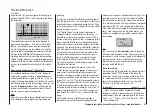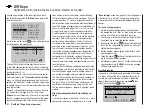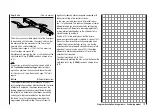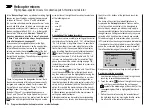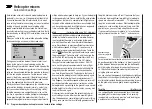
112
Program description: wing mixers – fixed-wing model
Simultaneously pressing the
or
buttons of the
right-hand touch-key (
CLEAR
) resets an altered value
to 0%.
The adjustment range is +/- 150%. For this mixer the
“usual” settings are again in the low two-digit range.
flap
elev
(Flap
elevator)
When the camber-changing flaps are lowered, either
using “
Phase trim
” or by means of a transmitter control
assigned to input “6”, a pitch trim change (up or down)
may occur. Alternatively it may be desirable for slight
down-elevator to be applied automatically when the
flaps are raised by a small amount, in order to increase
the model’s basic airspeed. This mixer can be used to
achieve both purposes.
When the flaps are deployed, this mixer causes the
elevator setting to be corrected automatically in propor-
tion to the flap deflection.
The adjustment range is +/- 150%. For this mixer the
“usual” settings are in the single to low two-digit range.
Simultaneously pressing the
or
buttons of the
right-hand touch-key (
CLEAR
) resets an altered value
to 0%.
their “up” end-point. The remedy here is to apply “dif-
ferential reduction”, which is explained in its own section
later.
elev
flap
(Elevator
flap)
The flaps can be used to enhance the effect of the el-
evator in tight turns and aerobatics, and this mixer feeds
part of the elevator signal to the flap servos. The mixer
direction must be set so that the flaps move down when
up-elevator is applied, and vice versa.
Simultaneously pressing the
or
buttons of the
right-hand touch-key (
CLEAR
) resets an altered value
to 0%.
The “usual” settings for this mixer are in the low two-digit
range.
elev
aile
(Elevator
aileron)
This mixer allows the ailerons to reinforce the elevator
response in the same way as the previous mixer.
provides elevator trim to counteract any unwanted pitch
trim change and maintain the model’s airspeed at a
safe level. This is necessary to avoid the danger of the
model slowing up excessively; if the landing approach is
started too soon, and has to be extended by retracting
the airbrakes again, the model could then stall abruptly.
This inter-action between the flaps, ailerons and elevator
is used to control the glide angle on the landing ap-
proach. Optionally the butterfly setting can also be used
without the airbrakes or spoilers; nowadays this is very
commonly used for sports and competition aircraft.
Note:
If your model features full-span (strip) ailerons which
also double as camber-changing flaps, the two mix-
ers “Brake
aileron” and “Brake
elevator” can be
combined for glide path control. In this case up-flap is
applied, but the flaps can still be controlled as ailerons.
Elevator pitch trim compensation is generally required.
If you have programmed aileron differential, the re-
sponse of the ailerons will inevitably be adversely
affected by the extreme “up” deflection of the ailerons
in the butterfly setting, because the differential travel
reduces or entirely suppresses the down-aileron de-
flection. However, the “up” travel of the ailerons is also
greatly restricted because they are already at or close to
* NN = Nomen Nominandum (name to be stated)
Содержание mx-12 Hott
Страница 1: ...Programming Manual 33116 mx 16 HoTT 3 en mx 16...
Страница 35: ...35 For your notes...
Страница 49: ...49 For your notes...
Страница 55: ...55 For your notes...
Страница 59: ...59 For your notes...
Страница 63: ...63 For your notes...
Страница 69: ...69 For your notes...
Страница 91: ...91 For your notes...
Страница 101: ...101 For your notes...
Страница 123: ...123 For your notes...
Страница 181: ...181 For your notes...
Страница 193: ...193 For your notes...


